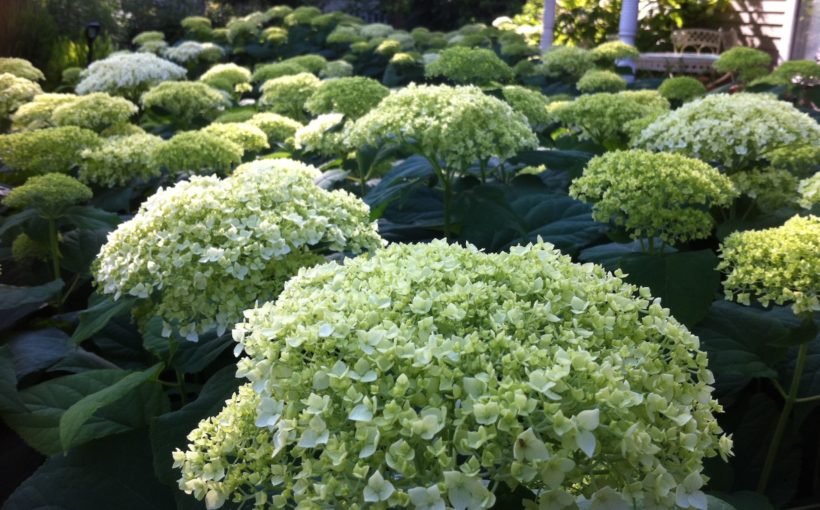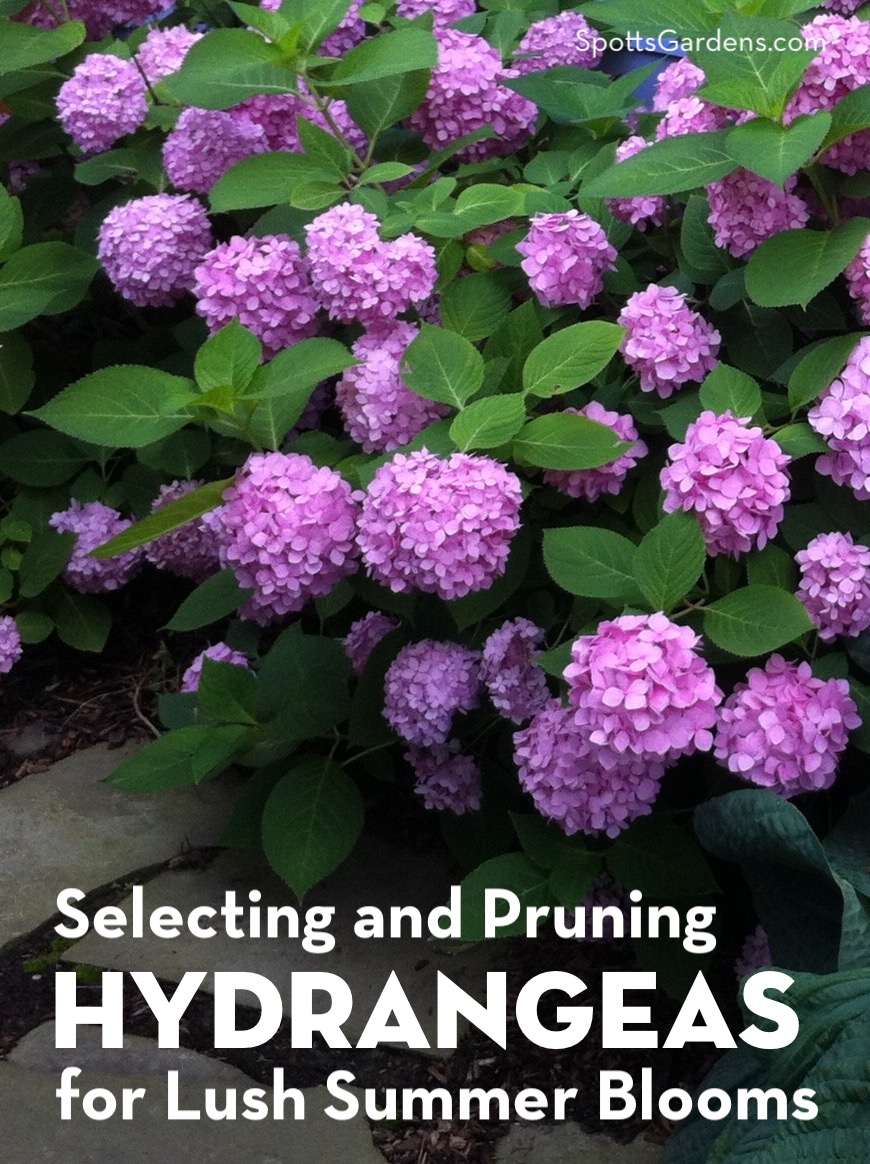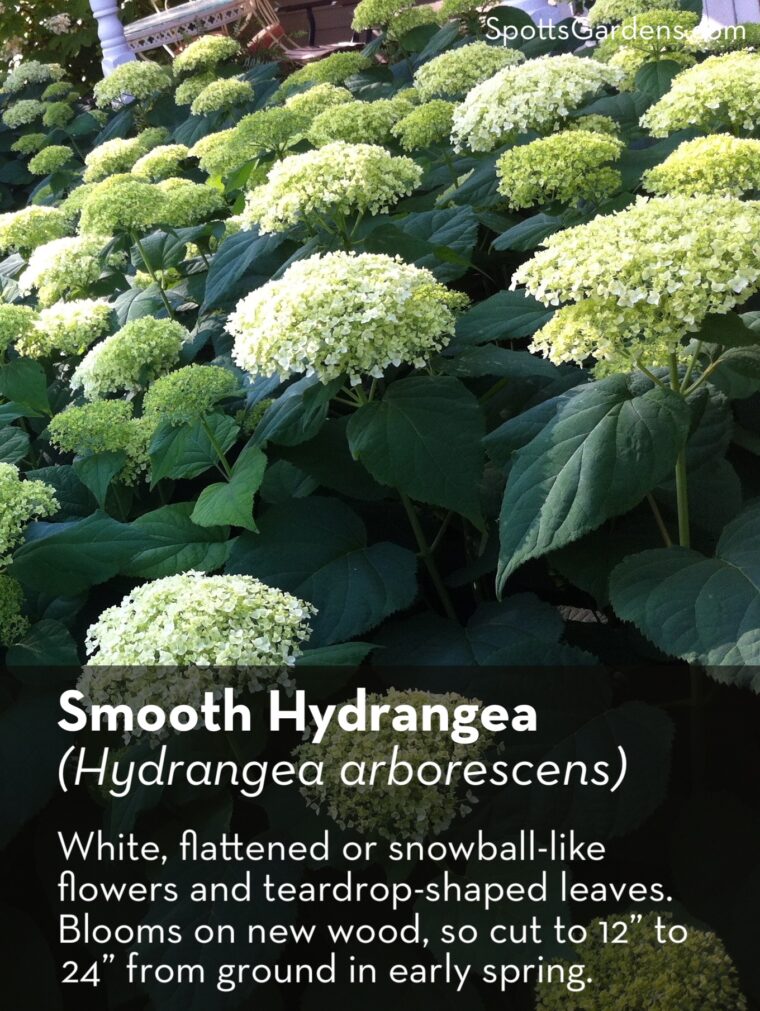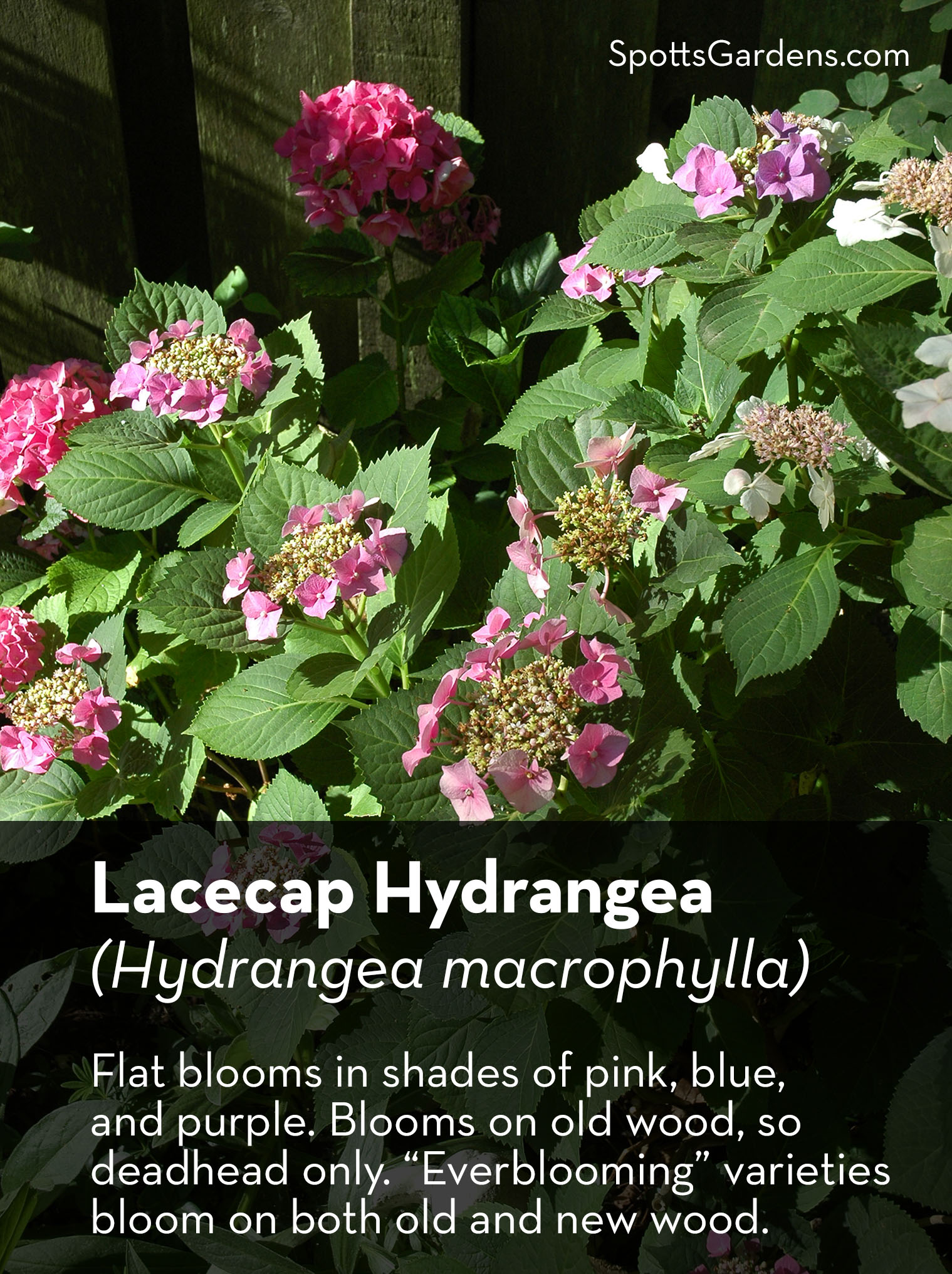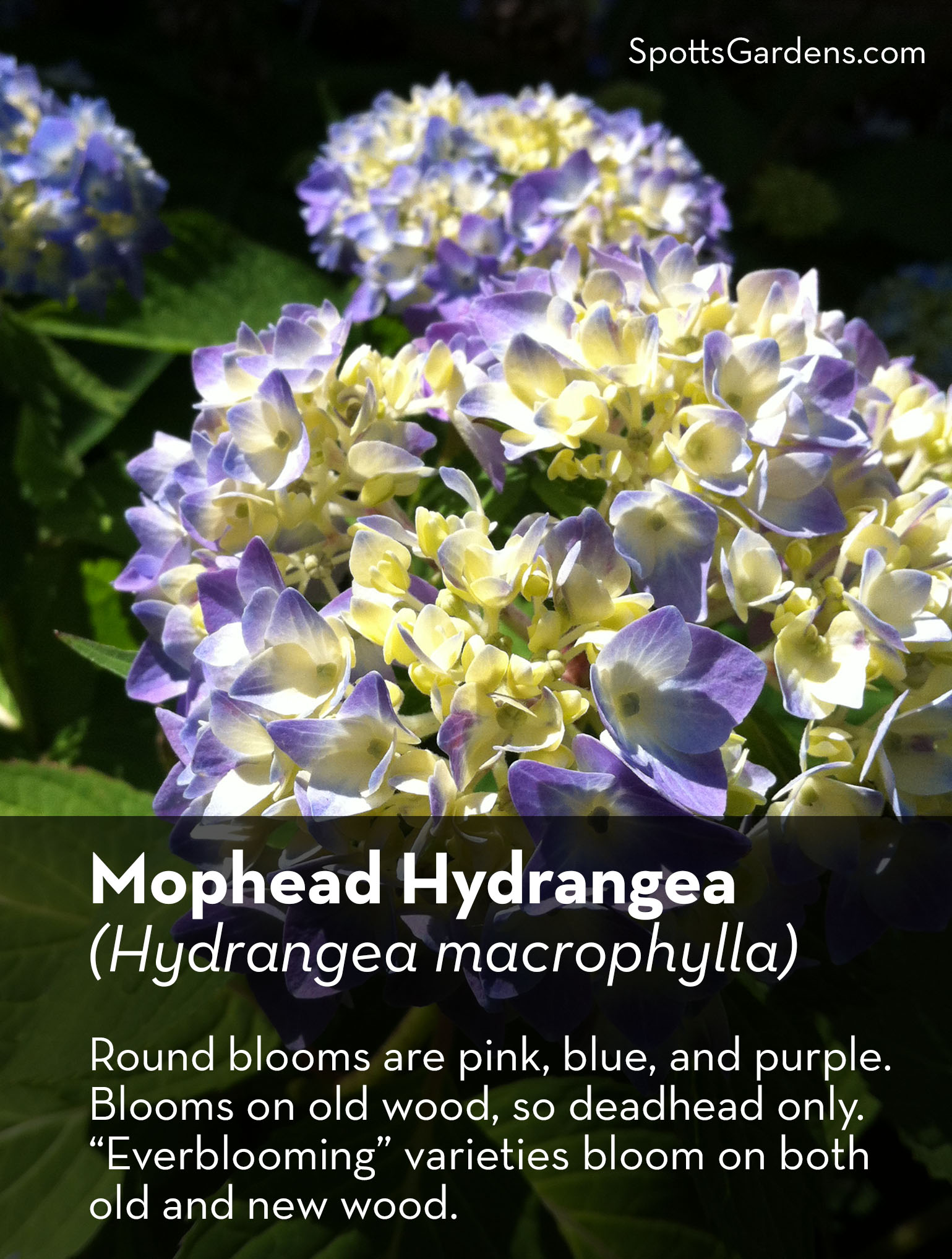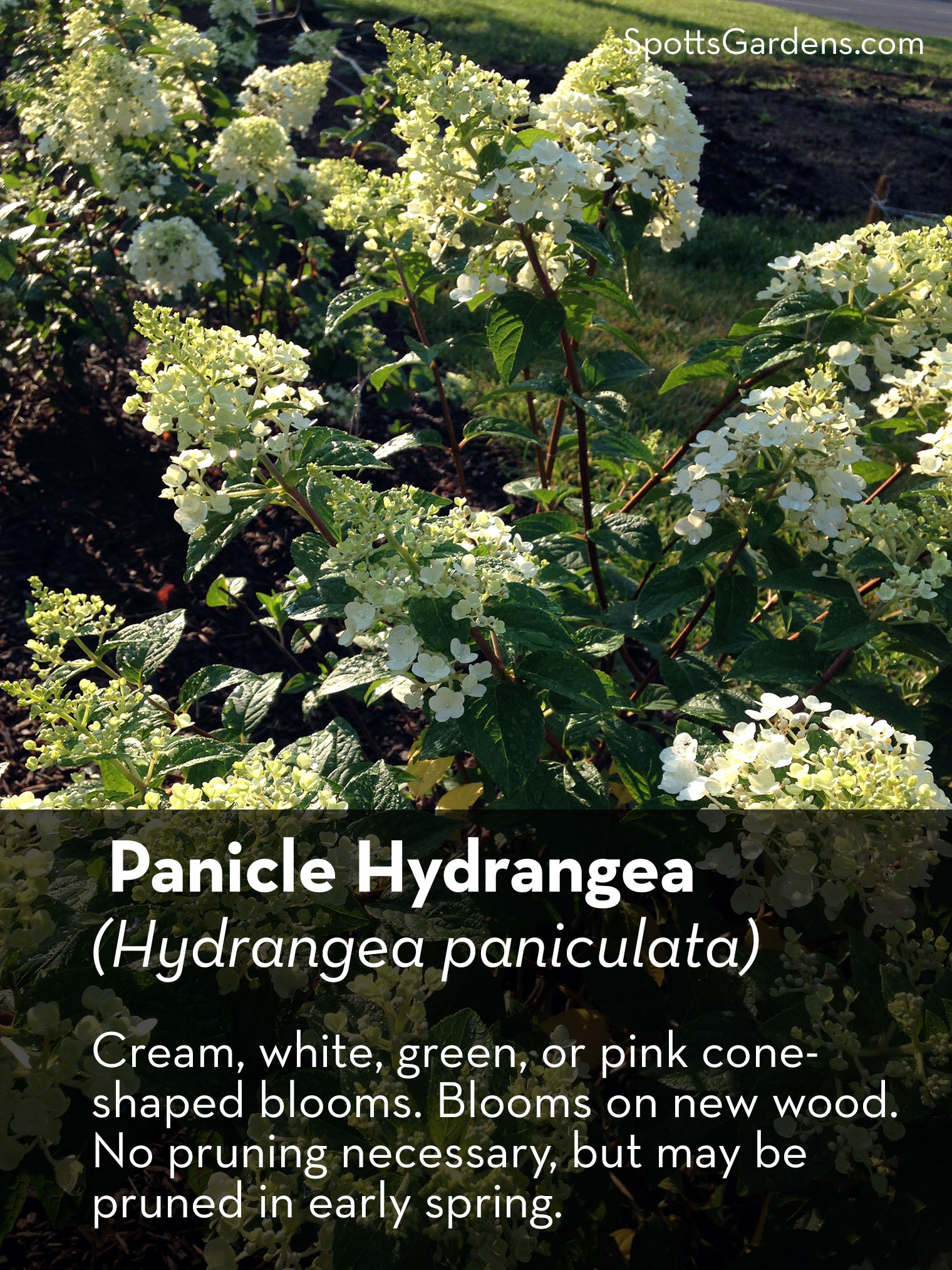For summer-long blooms in the garden, you can’t beat hydrangeas. They’re a low-maintenance way to add structure and reliable blooming to the flower border. And with so many available, you can find one for most spots in the garden.
But to get the most from your hydrangeas, you need to choose the right ones, then prune them correctly. Different species require different pruning methods. Check out our roundup of the most common hydrangeas below, and bring on the blooms!
Smooth Hydrangea (Hydrangea arborescens)
Our native smooth hydrangea gets about 3′ to 5′ tall and wide. The blooms are a mix of tiny, fertile flowers and larger, sterile white flowers that occur in the same slightly flattened cluster. Blooms are greenish when they open, mature to white, and often take on a maroon hue as they age.
Hardy in zones 3 to 9, this edge-of-the-woodland native prefers a part-shade location. It tends to flop late in summer as the puffy flowers get too heavy for the stems.
The most popular cultivar is ‘Annabelle,’ but the new ‘Incrediball‘ series boasts even larger blooms. These varieties are bred for large numbers of sterile blooms that appear in clusters that look like white or pink snowballs. Unfortunately, those softball-sized flowers don’t have pollen, so they’re no good for pollinators. Choose the straight species, Hydrangea arborescens, instead.
Pruning Smooth Hydrangea
H. arborescens blooms on new wood, which means the current season’s growth. Cut the stems to about 12″ to 24″ in early spring. Leaving them a foot or two tall provides a frame that helps hold up the new stems. Hydrangea arborescens is the only hydrangea we routinely cut down in the spring.
Bigleaf Hydrangea (Hydrangea macrophylla)
Bigleaf hydrangeas are those that bloom in shades of pink, purple, red, and blue. While some have a consistent color, others may bloom pink in alkaline soil and blue in acidic soil. If you want your hydrangeas to bloom blue, you’ll need to acidify your soil by adding soil sulfur. All of these hydrangeas age from their initial color to a maroon later in the summer.
Although “macrophylla” means “big leaf,” you’re more likely to hear these hydrangeas referred to by the shape of their blooms. The lacecap type has flat heads with tiny fertile flowers surrounded by larger, sterile flowers. The mophead type has big, rounded blooms.
These hydrangeas prefer a part-shade location. While the straight species is hardy from zones 6 to 9, many of the cultivated varieties are more cold hardy.
Pruning Bigleaf Hydrangea
H. macrophylla blooms on old wood. Bigleaf hydrangeas require no pruning, with the exception of deadheading to improve their look. If your bigleaf hydrangea needs some rejuvenating, cut out a few of the oldest stems all the way to the ground in spring.
Because H. macrophylla blooms on old wood, a particularly brutal winter can knock out all the buds without killing the plant. If this happens, just cross your fingers for a better winter; your hydrangea should bloom again the following year.
Special case: Reblooming Bigleaf Hydrangeas
Many of the most popular H. macrophylla varieties are “reblooming” or “everblooming,” like those in the ‘Endless Summer’ and ‘Let’s Dance’ series. If you’ve planted a bigleaf hydrangea in the last fifteen years, it’s probably an everblooming type.
In a normal season, rebloomers begin blooming on old wood in early summer, and then on new wood in late summer and fall. If a nasty winter knocks out the buds on the old wood, you’ll still get blooms on the new wood.
Pruning Reblooming Bigleaf Hydrangea
Don’t prune a reblooming hydrangea, as you’ll cut off the buds in the old wood. To keep it looking tidy, remove dead flower heads right below the bloom.
Despite their reputation for blooming well and continuously, sometimes rebloomers just peter out. We rejuvenate them by cutting them to the ground in spring every three or four years.
Panicle Hydrangea (Hydrangea paniculata)
The panicle hydrangea has cone-shaped clusters of flowers that initially bloom in shades of white, cream, green, or pink, then age to a maroon color later in the season. Panicle hydrangeas run the gamut in size, from dwarf varieties like 3′ tall ‘Bombshell’ (3’ x 3’) to 15′ tall Peegee. Other popular cultivars include ‘Little Lime,’ ‘Limelight,’ and ‘Little Quick Fire.’
Panicle hydrangeas thrive in full sun to part shade, provided the setting isn’t too hot. We’ve found they do well in full morning sun, preferring some shade in the afternoon. They are hardy in zones 3 to 9.
Pruning Panicle Hydrangea
H. paniculata blooms on new wood, so it needs no pruning at all. But if you want to rejuvenate the plant, you can prune it within a few feet of the ground in late winter or early spring. Spring pruning also can help control its size. To keep it looking tidy, remove dead flower heads right below the bloom.
Oakleaf Hydrangea (Hydrangea quercifolia)
The oakleaf hydrangea has cone-shaped flowers that bloom in whites and creams, aging to maroon later in the season. Its deeply cut leaves that look like those found on an oak tree. Varieties range in size from the 2′ tall ‘Sike’s Dwarf’ to the 8′ tall ‘Alice.’ Our favorites include ‘Munchkin,’ ‘Pee Wee,’ and ‘Snow Queen.’
This tough shrub thrives in full sun to full shade. As with the panicle hydrangea, we recommend avoiding very hot exposures. Hydrangea quercifolia is hardy in zones 5 to 9.
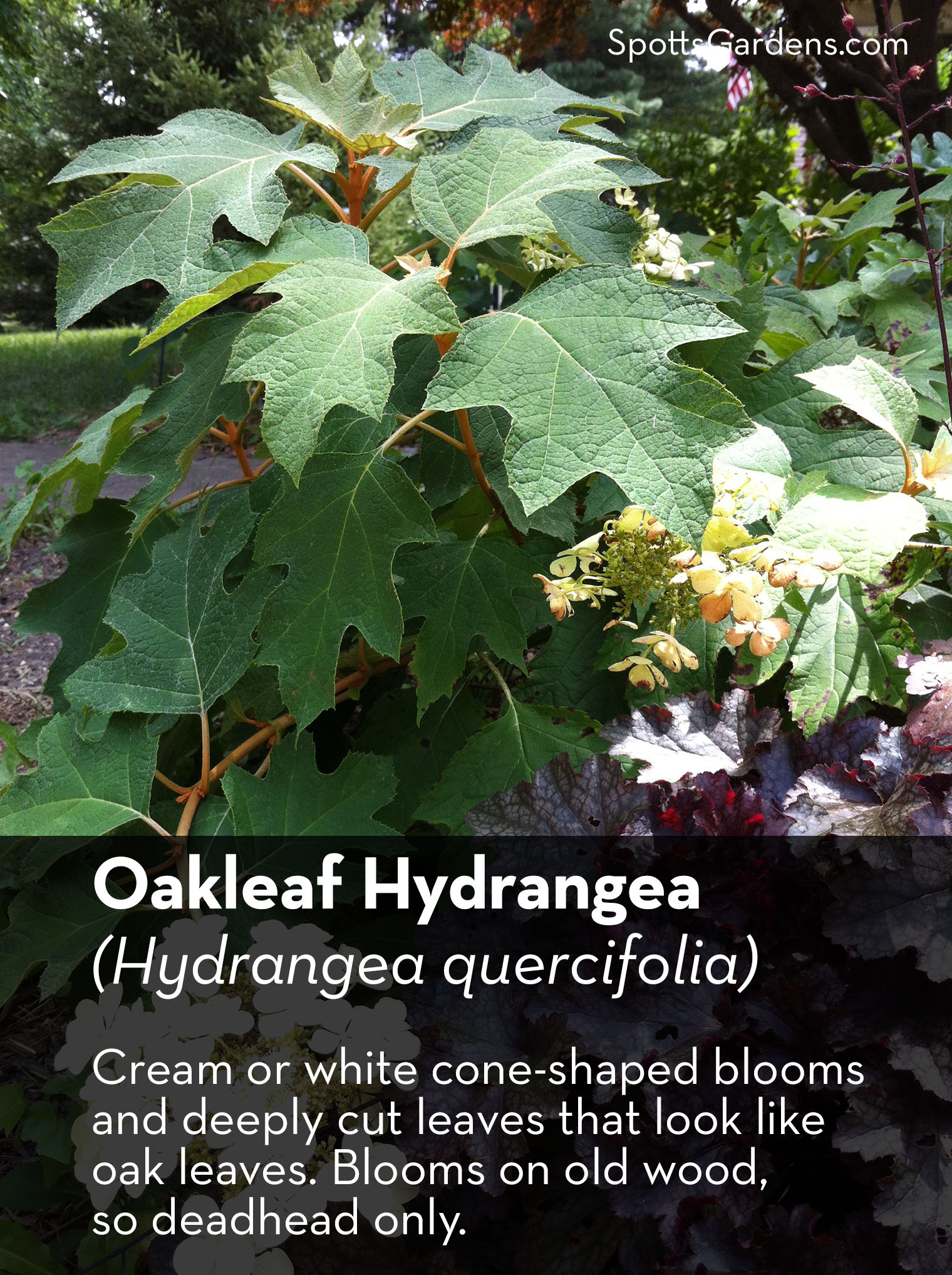
Pruning Oakleaf Hydrangea
H. quercifolia blooms on old wood, meaning the previous season’s growth. Oakleaf hydrangea doesn’t need pruning, unless it is damaged or overgrown. If you’d like to tidy it up, remove the dead flower heads just under the bloom.
If your oakleaf hydrangea is very old and woody, take out a few of the oldest, thickest stems all the way to the ground in the early spring to encourage some new growth. Don’t cut the entire plant to the ground, as you’ll both stress the plant and lose a whole season of blooms.
Other Hydrangeas
Mountain Hydrangea (Hydrangea serrata)
Varieties of Hydrangea serrata have only recently been introduced to central Indiana. These shrubs are much like H. macrophylla, although generally more compact. As with the bigleaf hydrangeas, their bloom color is sensitive to pH.
Mountain hydrangea is hardy zones 6 to 9. Because central Indiana is at the top of the hardiness range for these shrubs, we recommend siting them in fairly protected areas until we know how they perform in our winters. Bloom occurs on old wood, so do not prune them, with the exception of deadheading.
The varieties of the ‘Tuff Stuff’ series are rebloomers, so treat them as you would bigleaf hydrangea rebloomers like ‘Endless Summer.’
Climbing Hydrangea (Hydrangea anonmala subsp. petiolaris)
Climbing hydrangea can grow 60′ long, so it requires a sturdy structure for support. Otherwise, it will grow over the ground like ground cover. It climb with the aid of rootlets (“holdfasts”), so it can scale even solid walls without much guidance.
Hardy to zones 4 to 8, climbing hydrangea prefers part to full shade and moist soil. It can be slow to establish, but robust and long-lived once it acclimates. The lacecap-style white blooms flower in early summer.
Climbing hydrangea blooms on old wood and needs little pruning other than possibly deadheading. Prune it after blooming and only as necessary to keep it in bounds. If it’s wildly overgrown, you can prune it back after it blooms over a span of three years to reduce its size.
Spotts Garden Service can help you select new hydrangeas for your garden, or prune the ones you already have. Contact us for a free estimate.
